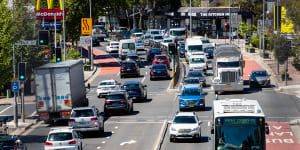Data from Transport for NSW shows road usage in Sydney in the week after restrictions were relaxed increased 18 per cent to 97 million vehicle movements compared to the previous week.

Traffic on major thoroughfares such as Military Road in Cremorne is creeping back to pre-COVID levels.Edwina Pickles
There was a 34 per cent rise in road usage since mid-September,indicating roads started to become busier during the last month of lockdown. However,there were fewer drivers on the road compared to the first week after lockdown in June 2020,with road usage down 6 per cent.
Public transport is also busier,with passengers taking 623,000 trips in the week after restrictions were eased,compared to 420,000 trips in the previous week.
But patronage is down 40 per cent compared to the first week after lockdown in June 2020 (1 million trips) and 74 per cent lower than the same period in 2019 (2.4 million trips).
Nick Abrahim,deputy chief executive of the NSW Taxi Council,said drivers had experienced a “significant increase” of vehicles on roads such as Parramatta Road,the M4 Motorway,Henry Lawson Drive,Milperra Road and Stacey Street in Bankstown since restrictions were eased.
“Peak-hour traffic seems to be running for longer periods than previous,” he said. “Drivers are finding earlier in the morning and late afternoons to be the busier period.”
Driving skills also appear to have worsened during lockdown,Mr Abrahim said. “We are seeing drivers less confident and more cautious,perhaps because it has been a while since driving.”
Some taxi drivers suggested driver behaviour was worse than pre-COVID,with drivers impatient and preoccupied by “mobile phones and other distractions”,Mr Abrahim said. “Some of our drivers are reporting that sounding your horn to the car in front when lights turn green is becoming more and more common.”
But David Levinson,professor of transport engineering at the University of Sydney,said:“In general low traffic levels lead to higher speeds and to more dangerous driving,so as traffic returns to normal,we may see lower rates of fatal and injury collisions per kilometre travelled.”
Taxi driver Ian Brown said he believed some motorists’ driving skills were rusty after the long lockdown.
“I’m not saying I’m perfect,but a lot of people are holding up traffic and making poor decisions,” he said. “It’s quite noticeable,and I think a lot of drivers will tell you that.”
The 71-year-old Mr Brown,who has been a taxi driver for more than three decades,said traffic was quickly returning to pre-COVID levels,especially on major roads such as Victoria Road. He said he was driving passengers to work or to go shopping,but few airport fares.
shows Sydney’s vehicle traffic last week was just 3 per cent lower than the pre-COVID levels recorded in January 2020. In comparison,walking was down 37 per cent,while public transport usage was 48 per cent lower than pre-COVID levels.
Data from Google shows visits to workplaces down 62 per cent in the City of Sydney after lockdown rules were eased. There were also significantly less trips to supermarkets and pharmacies,other shops and park,but residential visits were up 26 per cent.
A City of Sydney spokeswoman said there was a 113 per cent increase in pedestrians once lockdown restrictions were relaxed.
Cycling has been a resilient form of transport throughout Sydney’s lockdowns compared to other forms of transport,with the daily average number of trips on Liverpool Street in Sydney’s CBD only 12 per cent lower this month compared to pre-COVID levels.
Professor Levinson said empty CBD offices meant train carriages would also continue to be empty.
“Walking to work is also much more common for people in high-density areas,which are more likely still to be places where workers are effectively locked out,” he said. “And if the CBD is relatively empty,driving and parking there is not as difficult.”
Stay across the most crucial developments related to the pandemic with the Coronavirus Update.